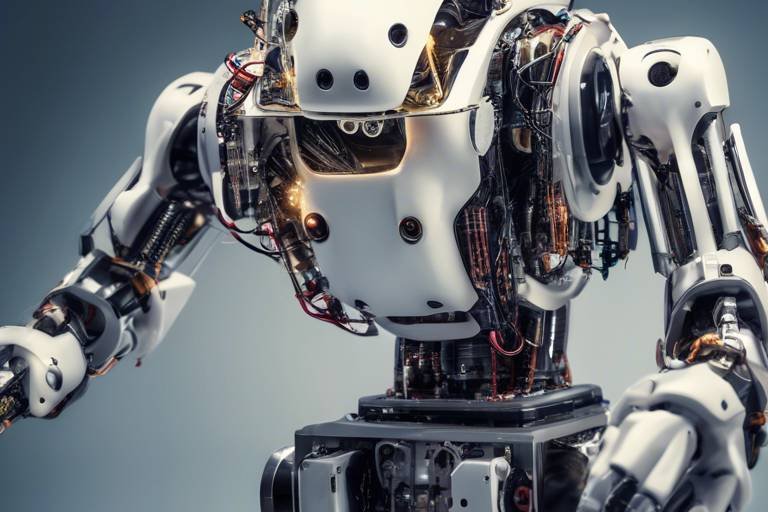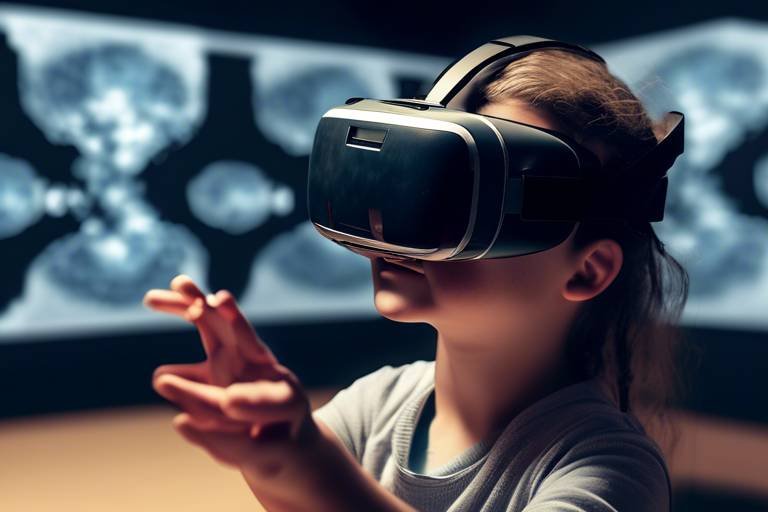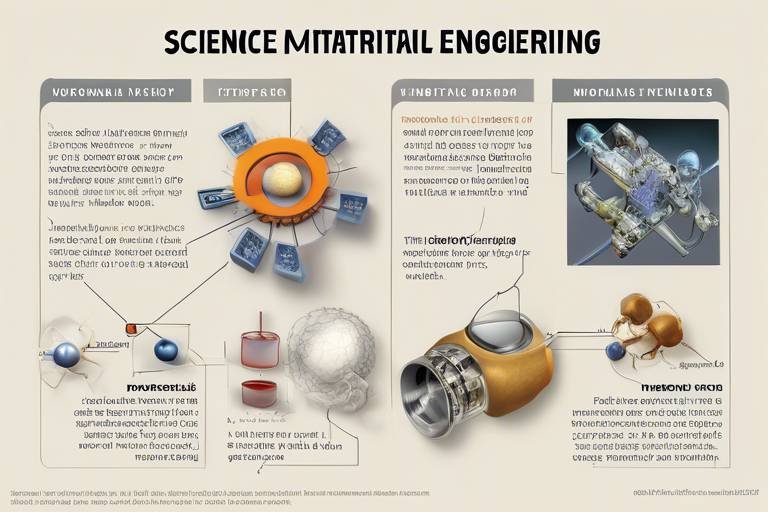How Technology is Impacting Human Evolution Studies
In today's fast-paced world, technology is not just a tool; it's a catalyst for change, especially in the realm of human evolution studies. Imagine being able to peer into the past with the same clarity as looking through a window. This is what modern technology offers researchers who are delving into the intricacies of our ancestry. From the tiniest genetic markers to the grandest fossil discoveries, technology is reshaping how we understand our origins. It’s like having a supercharged magnifying glass that reveals details previously hidden from view, allowing scientists to connect dots that were once mere speculation.
As we explore the impact of technology on human evolution studies, we find that the innovations in this field are not just enhancing traditional methods; they are creating entirely new avenues of research. With advancements in genetic sequencing, 3D imaging, artificial intelligence, and more, the landscape of evolutionary biology is shifting dramatically. Researchers are now equipped with tools that enable them to gather and analyze data in ways that were unimaginable just a few decades ago. This article will take you on a journey through the various technological advancements that are pushing the boundaries of our understanding of human evolution.
Genetic sequencing technologies have revolutionized the way researchers analyze DNA, enabling them to uncover evolutionary relationships and trace lineage with unprecedented accuracy and speed. Imagine being able to decode the genetic blueprint of ancient hominins, revealing secrets about their diets, habitats, and even their interactions with other species. This level of insight was once the stuff of science fiction, but today, it’s a reality. Techniques such as next-generation sequencing (NGS) allow scientists to sequence entire genomes quickly and cost-effectively, leading to discoveries that are reshaping our understanding of human ancestry.
3D imaging technologies allow scientists to create detailed models of fossils, facilitating better analysis of anatomical structures and providing insights into the physical traits of ancient species. Think of it as bringing fossils back to life in a virtual space. Researchers can examine the minutiae of bone structures, assess how these creatures moved, and even hypothesize about their behaviors. This technology not only enhances our understanding of the past but also helps in educating the next generation of scientists about the complexities of evolution.
AI algorithms are increasingly used to analyze vast datasets in evolutionary biology, helping researchers identify patterns and correlations that would be difficult to discern through traditional methods. Picture a detective sifting through mountains of evidence, but instead of a magnifying glass, they have a powerful computer analyzing every detail. AI can process data at lightning speed, uncovering trends that might take humans years to notice. This not only accelerates research but also opens new doors for understanding human evolution.
Remote sensing technologies enhance field research by enabling scientists to gather data from hard-to-reach areas, improving the understanding of human habitats and migration patterns throughout history. Imagine being able to survey vast landscapes from the comfort of a lab, pinpointing locations that are ripe for excavation. This capability allows researchers to focus their efforts more effectively, ensuring that they’re digging in the most promising spots. It’s like having a treasure map that highlights the best places to search for clues about our past.
Virtual reality tools are transforming educational approaches to human evolution, allowing students and researchers to immerse themselves in simulations that visualize evolutionary processes and ancient environments. Instead of reading about the evolution of species, students can experience it firsthand, exploring prehistoric landscapes and interacting with virtual representations of early humans. This immersive experience not only makes learning more engaging but also deepens understanding by allowing students to visualize complex concepts in a way that textbooks simply cannot.
Online collaborative platforms facilitate international research efforts, allowing scientists to share findings, methodologies, and data, thereby accelerating advancements in human evolution studies. In an age where knowledge is power, collaboration is key. Researchers from different corners of the globe can work together in real-time, pooling their resources and expertise. This collective approach leads to more comprehensive studies and faster discoveries, ultimately enriching our understanding of human evolution.
Wearable technology provides insights into contemporary human behavior, enabling researchers to study the effects of modern lifestyles on evolutionary traits and health. Imagine wearing a device that not only tracks your steps but also provides data on how your daily habits might influence your genetic makeup over generations. This fascinating intersection of technology and biology can reveal how our modern environment shapes our evolution, offering clues to our future as a species.
Bioinformatics tools are essential for modeling evolutionary processes, helping researchers simulate scenarios and predict future evolutionary trends based on current data. It’s akin to being able to look into a crystal ball that reflects not just the past but also potential futures. By analyzing genetic data and environmental factors, scientists can create models that illustrate how species might adapt or change over time. This predictive capability is invaluable for understanding the ongoing journey of human evolution.
As technology advances, ethical considerations in human evolution studies become increasingly important, prompting discussions about consent, privacy, and the implications of genetic manipulation. With great power comes great responsibility, and as researchers delve deeper into the genetic fabric of humanity, they must navigate the murky waters of ethics. Questions arise about who owns genetic information, how it should be used, and what rights individuals have over their genetic data. These discussions are crucial to ensure that the pursuit of knowledge does not come at the expense of ethical standards.
- What role does genetic sequencing play in human evolution studies? Genetic sequencing allows researchers to analyze DNA, uncovering evolutionary relationships and tracing lineage with great accuracy.
- How has 3D imaging changed fossil research? 3D imaging enables detailed models of fossils, providing insights into the anatomy and physical traits of ancient species.
- What ethical concerns are associated with advancements in technology? Ethical considerations include issues of consent, privacy, and the implications of genetic manipulation in research.

Advancements in Genetic Sequencing
In the realm of human evolution studies, genetic sequencing technologies have emerged as a game changer, reshaping how researchers analyze DNA. Imagine being able to peel back the layers of our ancestry with the precision of a surgeon—this is the power that modern sequencing offers. With the advent of next-generation sequencing (NGS), scientists can now decode entire genomes in a fraction of the time it once took, allowing them to uncover evolutionary relationships and trace lineage with unprecedented accuracy and speed.
One of the most fascinating aspects of these advancements is the ability to compare ancient DNA with that of modern humans. This comparison provides insights into how our species has adapted over millennia. For instance, researchers have been able to identify genetic markers that indicate how early humans adapted to varying climates and diets. This knowledge not only enriches our understanding of human history but also sheds light on current health issues, as many of these adaptations can influence modern human physiology.
Moreover, the integration of bioinformatics tools has further enhanced the capabilities of genetic sequencing. These tools allow scientists to analyze vast amounts of data efficiently, identifying patterns and correlations that would otherwise remain hidden. For example, using sophisticated algorithms, researchers can pinpoint genetic variations that might have conferred advantages in survival, leading to fascinating discoveries about our evolutionary past.
As genetic sequencing continues to evolve, it opens doors to new questions and research avenues. Scientists are now exploring the genetic basis of traits that define us as humans, such as our cognitive abilities and social behaviors. This exploration not only deepens our understanding of what it means to be human but also raises ethical considerations about how this knowledge is applied. The potential for genetic manipulation in the future could redefine our species, making it imperative that we tread carefully.
In summary, the advancements in genetic sequencing are not just tools for researchers; they are keys to unlocking the complex narrative of human evolution. As we continue to harness these technologies, we find ourselves on the brink of discoveries that could change our understanding of who we are and where we come from.

3D Imaging and Fossil Reconstruction
In the realm of paleontology, the advent of 3D imaging technologies has been nothing short of revolutionary. Imagine being able to walk through a digital museum where the ancient skeletons of dinosaurs and early humans are not just static displays but vibrant, interactive models. This innovation allows scientists to create detailed, accurate models of fossils that were once considered too fragile to handle. By utilizing techniques like CT scanning and laser scanning, researchers can capture the intricate details of fossilized remains, enabling them to analyze anatomical structures with a level of precision that was previously unimaginable.
One of the most exciting aspects of 3D imaging is its ability to facilitate fossil reconstruction. Traditionally, reconstructing a fossil involved painstaking manual work—gluing pieces together and often making educated guesses about missing parts. Now, with 3D imaging, scientists can create virtual reconstructions that allow for more accurate representations of how these ancient beings might have looked and moved. This technology not only enhances our understanding of physical traits but also provides insights into the behavior and ecology of these species. For instance, researchers can simulate how a dinosaur might have hunted or how early hominins adapted to their environments.
Furthermore, the use of 3D models has significant implications for education and public engagement. Students and enthusiasts can explore virtual fossils in ways that were once limited to professional researchers. Imagine a classroom where students can manipulate a 3D model of a Neanderthal skull, examining its features up close. This interactive learning experience fosters a deeper understanding of human evolution and the complexities of our ancestry.
To illustrate the impact of 3D imaging on fossil reconstruction, consider the following table that highlights key technologies and their applications:
| Technology | Application |
|---|---|
| CT Scanning | Non-destructive imaging of internal structures |
| Laser Scanning | High-resolution surface modeling |
| Photogrammetry | Creating 3D models from photographs |
| Virtual Reality | Immersive exploration of fossil environments |
As we continue to refine these technologies, the potential for new discoveries in human evolution studies is immense. With every scan and model created, we peel back layers of history, revealing not just the physical forms of our ancestors but also the stories they tell about adaptation, survival, and the intricate web of life on Earth. The fusion of technology and paleontology is creating a dynamic landscape for research, where the past is not just learned but experienced.
- What is 3D imaging in paleontology?
3D imaging in paleontology refers to the use of advanced scanning technologies to create detailed digital models of fossils, allowing for in-depth analysis and reconstruction without damaging the original specimens. - How does 3D imaging improve fossil reconstruction?
It allows scientists to visualize and manipulate fossil structures in a virtual environment, leading to more accurate reconstructions and a better understanding of ancient species' anatomy and behavior. - Can 3D imaging be used for educational purposes?
Absolutely! 3D models can be used in classrooms and museums to enhance learning experiences, making ancient life more accessible and engaging for students and the public.

Artificial Intelligence in Data Analysis
Artificial Intelligence (AI) is not just a buzzword; it's a game-changer in the realm of human evolution studies. Imagine trying to sift through mountains of data, akin to finding a needle in a haystack. Traditional methods can be painstakingly slow, and researchers often find themselves overwhelmed by the sheer volume of information. However, with AI stepping onto the scene, this process has been transformed dramatically. AI algorithms can analyze vast datasets at lightning speed, identifying patterns and correlations that would take humans years to uncover. This capability is particularly valuable in evolutionary biology, where understanding complex relationships and trends is crucial.
One of the standout features of AI in this field is its ability to enhance predictive modeling. For instance, researchers can use AI to simulate evolutionary scenarios based on current genetic data. This predictive power allows scientists to make educated guesses about how species might evolve in response to environmental changes. It's like having a crystal ball that provides insights into the future of human evolution, helping to answer questions about adaptation and survival in a rapidly changing world.
Moreover, AI can improve the accuracy of data interpretation. In the past, researchers often relied on their intuition and experience to draw conclusions from data. With AI, those interpretations are backed by robust algorithms that minimize human error. This leads to more reliable results and a deeper understanding of our evolutionary past. For example, AI can analyze genetic sequences from ancient remains, revealing connections between modern humans and our ancestors with remarkable precision.
As we delve deeper into the integration of AI in evolutionary studies, it's essential to acknowledge the collaborative nature of this technology. AI systems can process data from multiple sources, allowing researchers from different disciplines to work together more effectively. This collaboration can lead to groundbreaking discoveries that might not have been possible in isolation. In essence, AI acts as a bridge, connecting various fields of study and fostering a multidisciplinary approach to understanding human evolution.
However, the benefits of AI come with challenges. The reliance on algorithms raises questions about the transparency of data analysis. How do we ensure that the AI systems we use are not biased? Researchers must remain vigilant and implement rigorous checks to maintain the integrity of their findings. This is where ethical considerations come into play, ensuring that the use of AI in human evolution studies is both responsible and effective.
In conclusion, the integration of Artificial Intelligence in data analysis is revolutionizing the study of human evolution. By enhancing predictive modeling, improving accuracy, and fostering collaboration, AI is not just a tool but a vital partner in uncovering the mysteries of our past. As we continue to embrace these technological advancements, we must also prioritize ethical considerations to ensure that our quest for knowledge does not compromise our values.
- What role does AI play in human evolution studies? AI helps analyze large datasets quickly, identifies patterns, and improves predictive modeling.
- Can AI replace human researchers in evolutionary biology? While AI enhances research capabilities, human intuition and ethical considerations remain crucial.
- What are the ethical concerns surrounding AI in this field? Issues include data privacy, algorithmic bias, and the transparency of AI processes.

Field Research and Remote Sensing
Field research has always been the backbone of studying human evolution, but with the advent of remote sensing technologies, this field has experienced a significant transformation. Imagine being able to gather data from locations that are otherwise inaccessible due to geographical barriers, harsh climates, or even political instability. Remote sensing allows scientists to do just that, providing a bird's-eye view of potential archaeological sites and ancient habitats without ever setting foot on the ground.
Using sophisticated tools like satellite imagery and drone technology, researchers can now analyze landscapes, identify patterns, and even detect subtle changes in the environment over time. This is particularly important when studying human migration patterns, as it enables scientists to visualize how ancient populations interacted with their surroundings. For instance, by examining soil compositions and vegetation patterns from above, researchers can infer how early humans adapted to various ecosystems.
Furthermore, remote sensing provides a broader context for understanding the evolutionary journey of our ancestors. By integrating data from various sources, scientists can create comprehensive maps that highlight migration routes and habitat changes over millennia. This holistic approach not only enriches our understanding of human evolution but also sheds light on the environmental factors that influenced our ancestors' development.
One of the most exciting aspects of remote sensing is its ability to complement traditional fieldwork. While digging up fossils and artifacts remains crucial, remote sensing can guide researchers to the most promising sites, saving time and resources. It’s like having a treasure map that points to where the next big discovery might be buried! This synergy between technology and hands-on research is paving the way for exciting new findings in the field of human evolution.
However, it's essential to recognize that remote sensing is not without its challenges. Data interpretation requires a high level of expertise, and the technology itself can be expensive and complex. Despite these hurdles, the benefits are undeniable. As remote sensing continues to evolve, it promises to unlock new insights into our past, helping us understand not just where we came from, but also how we became who we are today.
- What is remote sensing? Remote sensing is the acquisition of information about an object or area from a distance, typically using satellite or aerial imagery.
- How does remote sensing aid in human evolution studies? It allows researchers to gather data from hard-to-reach areas, analyze landscapes, and understand ancient habitats and migration patterns.
- What are some technologies used in remote sensing? Technologies include satellite imagery, drones, and various imaging techniques that capture environmental data.
- Can remote sensing replace traditional fieldwork? While it enhances field research, remote sensing is intended to complement traditional methods rather than replace them.
- What are the challenges of using remote sensing? Challenges include the high cost of technology, the complexity of data interpretation, and the need for specialized knowledge.

Virtual Reality in Education
Virtual Reality (VR) is not just a buzzword; it's a game-changer in the field of education, especially when it comes to complex subjects like human evolution. Imagine stepping into a world where you can walk alongside ancient hominins, observe their behaviors, and even interact with their environments. This immersive experience can transform the way students and researchers grasp the intricate details of our evolutionary history. With VR, learning becomes an adventure rather than a chore, sparking curiosity and engagement in ways traditional methods often fail to achieve.
One of the most exciting aspects of VR in education is its ability to create interactive simulations. These simulations can transport users to various periods in history, allowing them to experience the life of early humans firsthand. For instance, students could virtually explore a prehistoric landscape, hunt for food, or gather around a fire, gaining insights into the daily challenges faced by our ancestors. This kind of experiential learning can deepen understanding and retention, making the lessons stick in a way that textbooks simply cannot.
Moreover, VR can cater to different learning styles. Visual learners can benefit from stunning, lifelike graphics, while kinesthetic learners can engage in hands-on activities within the virtual environment. This adaptability makes VR an inclusive educational tool that can reach a wider audience. Consider the following key benefits of using virtual reality in education:
- Enhanced Engagement: Students are more likely to be engaged when they can interact with the material in a dynamic way.
- Realistic Experiences: VR provides a safe space to explore scenarios that would be impossible or dangerous in real life.
- Collaboration Opportunities: VR can facilitate group activities, allowing students to work together in a shared virtual space, regardless of their physical locations.
As educational institutions begin to adopt VR technologies, the potential to revolutionize the study of human evolution becomes increasingly apparent. Imagine a classroom where students can not only learn about the evolution of species but actually witness it. Such experiences can foster a deeper appreciation for our shared history and the complexities of biological change over time.
However, it's essential to recognize that while VR holds immense promise, it also comes with challenges. The cost of developing and implementing VR programs can be high, and there is a need for ongoing training for educators to effectively integrate this technology into their teaching. Additionally, as with any technology, there are concerns about accessibility and ensuring that all students can benefit from these advancements.
In conclusion, Virtual Reality is reshaping education by providing immersive, engaging, and interactive learning experiences. As we continue to explore the depths of human evolution, VR stands as a powerful tool that can enhance our understanding and appreciation of our past. The future of education is bright, and with VR at the forefront, the possibilities are endless.
| Question | Answer |
|---|---|
| What is Virtual Reality? | Virtual Reality is a simulated experience that can be similar to or completely different from the real world, often using technology to create immersive environments. |
| How is VR used in education? | VR is used in education to create immersive learning experiences that engage students and provide them with opportunities to explore subjects in a hands-on way. |
| What are the benefits of using VR in learning about human evolution? | Benefits include enhanced engagement, realistic experiences, and collaboration opportunities, which can lead to a deeper understanding of evolutionary concepts. |
| Are there challenges to implementing VR in education? | Yes, challenges include high costs, the need for teacher training, and ensuring accessibility for all students. |

Collaborative Platforms for Global Research
In today’s interconnected world, the study of human evolution has been significantly enhanced by the rise of collaborative platforms. These digital spaces allow researchers from various corners of the globe to come together, share their findings, and collaborate on groundbreaking projects. Imagine a virtual laboratory where scientists from different continents unite to piece together the puzzle of our ancestry—this is the reality that modern technology has made possible!
One of the most exciting aspects of these platforms is their ability to break down geographical barriers. No longer do researchers have to rely solely on local resources or wait for conferences to share their insights. Instead, they can engage in real-time discussions, share data, and even co-author papers with colleagues they may never meet face-to-face. This has led to a rich exchange of ideas and a more diverse array of perspectives, ultimately enriching the field of human evolution studies.
Moreover, many of these platforms incorporate user-friendly tools that facilitate data sharing and project management. For instance, researchers can upload datasets, access shared resources, and utilize collaborative software to analyze findings collectively. This not only speeds up the research process but also ensures that important data is preserved and accessible to all collaborators. A great example of this is the use of cloud-based platforms, where researchers can store vast amounts of genetic data and access it from anywhere in the world, fostering a more inclusive research environment.
As the global scientific community continues to embrace these collaborative tools, we are witnessing the emergence of international research networks. These networks are often organized around specific themes or challenges in human evolution, allowing for targeted collaboration. For example, a project focused on the migration patterns of early humans might involve geneticists, archaeologists, and geologists working together to piece together a comprehensive narrative of our past. The synergy created in these environments can lead to innovative approaches and solutions that would be challenging to achieve in isolation.
However, while collaborative platforms offer numerous advantages, they also present challenges. Issues such as data privacy, intellectual property rights, and the digital divide must be addressed to ensure that collaboration is both effective and equitable. Researchers must navigate these complexities carefully to foster an environment that promotes open science while safeguarding individual contributions and sensitive information.
In conclusion, collaborative platforms are reshaping the landscape of human evolution research. They enable unprecedented levels of cooperation and innovation, allowing scientists to work together across borders and disciplines. As these platforms continue to evolve, they hold the promise of unlocking new insights into our evolutionary history, bringing us closer to understanding what it means to be human.
- What are collaborative platforms? Collaborative platforms are digital tools that allow researchers to work together, share data, and communicate in real-time, regardless of their physical location.
- How do these platforms enhance research? They facilitate faster data sharing, enable diverse perspectives, and foster international collaboration, leading to richer research outcomes.
- What challenges do collaborative platforms face? Issues such as data privacy, intellectual property rights, and the digital divide are significant challenges that need to be addressed.

Wearable Technology and Human Behavior
In today's fast-paced world, wearable technology has become more than just a trend; it's a revolution that is reshaping our understanding of human behavior. From smartwatches that track our heart rates to fitness bands that monitor our physical activity, these devices are not only making our lives more convenient but are also providing researchers with unprecedented insights into how modern lifestyles impact our evolutionary traits. Imagine having a tiny lab on your wrist, constantly collecting data about your body and its responses to various stimuli. This is the reality of wearable technology.
But how exactly does this technology influence our understanding of human behavior? First, let's consider the data collection capabilities of these devices. Wearable technologies can gather real-time data on various physiological metrics, including heart rate, sleep patterns, and even stress levels. Researchers can analyze this data to discern patterns that were previously difficult to identify. For instance, studies have shown that consistent monitoring can reveal how our bodies respond to different environments or stressors, allowing scientists to draw connections to our evolutionary past.
Moreover, wearable technology has opened new avenues for studying health and fitness behaviors. By tracking physical activity levels, researchers can assess how lifestyle changes affect our health. For example, a study utilizing wearable fitness trackers found that individuals who monitored their activity levels were more likely to engage in regular exercise. This correlation suggests that the awareness brought about by wearable technology could lead to behavioral changes that promote healthier lifestyles, which is crucial for understanding the evolutionary pressures that shape our species.
It's also fascinating to note how these devices can provide insights into social behaviors. Wearable technology often incorporates social features that allow users to share their achievements with friends or participate in challenges. This social aspect can foster a sense of community and competition, influencing how individuals approach fitness and health. Researchers are beginning to explore how these social dynamics could reflect evolutionary traits related to cooperation and competition among early human societies.
However, as we embrace the benefits of wearable technology, it's essential to consider the implications it has on our understanding of human evolution. One critical aspect is the impact on privacy. With so much personal data being collected, questions arise about who has access to this information and how it is used. Researchers must navigate these ethical considerations carefully, ensuring that the pursuit of knowledge does not come at the expense of individual privacy.
In conclusion, wearable technology is not just changing the way we live; it is also transforming the landscape of human behavior research. By providing a wealth of data and insights, these devices are helping us understand the complex interplay between modern lifestyles and our evolutionary history. As we continue to explore this intersection, we can look forward to uncovering more about what it means to be human in an ever-evolving world.
- What types of wearable technology are commonly used in research? Wearable devices such as fitness trackers, smartwatches, and health monitors are commonly used to gather data on physical activity, heart rate, and sleep patterns.
- How does wearable technology help in understanding human behavior? By collecting real-time data, researchers can analyze patterns and correlations related to health, fitness, and social interactions, providing insights into how modern lifestyles impact our evolutionary traits.
- Are there ethical concerns associated with wearable technology? Yes, issues related to privacy and data security are significant concerns, as personal information collected by these devices can be sensitive and potentially misused.

Bioinformatics and Evolutionary Modeling
In the realm of human evolution studies, bioinformatics has emerged as a powerful ally, transforming how researchers approach the complexities of evolutionary modeling. By integrating biology, computer science, and mathematics, bioinformatics enables scientists to analyze biological data on an unprecedented scale. Imagine trying to solve a puzzle with thousands of pieces scattered across a vast landscape—this is akin to the challenge faced by evolutionary biologists. However, with bioinformatics tools, they can gather these pieces, analyze them, and construct a coherent picture of evolutionary history.
One of the primary functions of bioinformatics in evolutionary studies is to manage and interpret vast amounts of genetic data. As sequencing technologies advance, the volume of genetic information available for analysis increases exponentially. Researchers can now sequence the genomes of various species, providing insights into their evolutionary relationships. By comparing genetic sequences, scientists can identify common ancestors and trace the lineage of specific traits through generations. This process is akin to mapping out a family tree, but on a much grander scale, revealing connections that span millions of years.
Furthermore, bioinformatics allows for the simulation of evolutionary processes. Using sophisticated algorithms, researchers can model how species might evolve under various environmental pressures. For instance, they might simulate how a population of early humans adapted to changing climates or food sources. Such simulations not only help in understanding past evolutionary events but also allow scientists to make predictions about future trends. This predictive capacity is crucial, especially in an era where rapid environmental changes pose new challenges for survival.
To illustrate the impact of bioinformatics on evolutionary modeling, consider the following table, which summarizes the key applications:
| Application | Description |
|---|---|
| Genomic Comparisons | Analyzing genetic sequences to determine evolutionary relationships. |
| Phylogenetic Analysis | Constructing evolutionary trees based on genetic data. |
| Simulation Models | Predicting evolutionary outcomes based on environmental changes. |
| Data Integration | Combining datasets from various sources for comprehensive analysis. |
Moreover, bioinformatics is not just about crunching numbers and analyzing data; it fosters collaboration among scientists worldwide. By sharing datasets and methodologies, researchers can build on each other’s work, leading to more robust conclusions. This collaborative spirit is essential in evolutionary studies, where understanding the intricate web of life requires diverse expertise and perspectives.
As we delve deeper into the age of information, the role of bioinformatics in evolutionary modeling will only grow more significant. It is a bridge connecting the past to the present and guiding us toward understanding the future of human evolution. With every new discovery, we inch closer to unraveling the mysteries of our origins and how we continue to adapt in an ever-changing world.
- What is bioinformatics? Bioinformatics is the application of computer technology to manage and analyze biological data, particularly in genetics.
- How does bioinformatics help in evolutionary studies? It allows researchers to analyze genetic data, simulate evolutionary processes, and understand the relationships between species.
- What are some tools used in bioinformatics? Common tools include sequence alignment software, phylogenetic analysis tools, and databases for storing genetic information.
- Why is collaboration important in bioinformatics? Collaboration enables researchers to share data and methodologies, leading to more comprehensive and robust evolutionary models.

Ethical Considerations in Technological Advancements
As we navigate the exciting landscape of technological advancements in the study of human evolution, it's crucial to pause and reflect on the ethical considerations that accompany these innovations. With great power comes great responsibility, and this adage rings especially true in the realm of genetic research and data analysis. The ability to sequence DNA with precision, reconstruct ancient fossils, and utilize artificial intelligence to analyze complex datasets opens up a Pandora's box of ethical dilemmas that researchers must address.
One of the primary concerns revolves around consent. In genetic studies, obtaining informed consent from individuals whose DNA is being analyzed is paramount. Researchers must ensure that participants understand how their genetic information will be used, stored, and shared. Furthermore, as we delve deeper into the intricacies of our ancestry, questions arise about the implications of revealing sensitive information that could affect individuals or communities. For instance, what happens if genetic data reveals predispositions to certain diseases or ancestral backgrounds that individuals were unaware of? This kind of knowledge can be both enlightening and burdensome.
Another ethical consideration is privacy. With advancements in technology, the potential for misuse of genetic data increases. Researchers must implement stringent measures to protect individual identities and ensure that data is anonymized. The fear of genetic discrimination—where individuals might be treated differently based on their genetic information—looms large. This is particularly relevant in contexts such as employment and insurance, where genetic predispositions could unjustly influence decisions.
Moreover, the implications of genetic manipulation raise significant ethical questions. As we gain the ability to edit genes, the line between natural evolution and human intervention becomes blurred. While the prospect of eradicating genetic diseases is tantalizing, it also prompts discussions about "designer babies" and the potential for creating inequalities based on genetic enhancements. This leads us to ponder: should we play God in the realm of evolution? These are not just scientific questions; they are deeply philosophical and societal ones.
In addition to these concerns, the use of advanced technologies in field research, such as remote sensing, brings forth issues of environmental ethics. As researchers access previously unreachable areas, the impact on local ecosystems and communities must be considered. The balance between scientific exploration and environmental conservation is delicate, and researchers must tread carefully to avoid damaging the very habitats they seek to study.
To navigate these complex ethical waters, it is essential for researchers to engage in open dialogues with ethicists, community leaders, and the public. Establishing ethical guidelines and frameworks can help ensure that technological advancements in human evolution studies are conducted responsibly. Collaborative efforts can lead to the development of best practices that prioritize the welfare of individuals and communities while advancing scientific knowledge.
In conclusion, while technology offers unprecedented opportunities to enhance our understanding of human evolution, it also necessitates a careful consideration of the ethical implications. As we forge ahead, we must remain vigilant and conscientious, ensuring that our quest for knowledge does not come at the expense of our humanity.
- What are the main ethical concerns in human evolution studies? The primary concerns include consent, privacy, genetic manipulation, and environmental ethics.
- How can researchers ensure informed consent? Researchers should clearly communicate how genetic data will be used and obtain explicit permission from participants.
- What is genetic discrimination? Genetic discrimination occurs when individuals are treated unfairly based on their genetic information, particularly in employment and insurance.
- Why is environmental ethics important in field research? Environmental ethics ensures that scientific exploration does not harm local ecosystems or communities.
Frequently Asked Questions
- How has technology changed the way we study human evolution?
Technology has significantly transformed human evolution studies by introducing advanced tools like genetic sequencing, 3D imaging, and AI. These innovations enhance our ability to analyze DNA, reconstruct fossils, and identify complex patterns in evolutionary data, making research faster and more accurate.
- What role does genetic sequencing play in understanding our ancestry?
Genetic sequencing allows researchers to decode DNA with remarkable precision, helping them uncover evolutionary relationships and trace lineage back through generations. This technology provides insights into how different species are related and how they have adapted over time.
- Can you explain how 3D imaging is used in fossil studies?
3D imaging technologies enable scientists to create detailed digital models of fossils. This process allows for in-depth analysis of anatomical structures and provides clearer insights into the physical traits of ancient species, which can reveal much about their behavior and environment.
- What impact does artificial intelligence have on evolutionary biology?
AI is revolutionizing evolutionary biology by analyzing large datasets to identify patterns and correlations that may not be evident through traditional methods. This capability helps researchers draw new conclusions about evolutionary processes and human behavior.
- How does remote sensing enhance field research?
Remote sensing technologies allow scientists to collect data from difficult-to-access locations, improving our understanding of historical human habitats and migration patterns. This technology provides a broader view of how ancient humans lived and adapted to their environments.
- What is the significance of virtual reality in education about human evolution?
Virtual reality tools are changing the educational landscape by allowing students and researchers to experience simulations that visualize evolutionary processes and ancient environments. This immersive learning approach makes complex concepts easier to grasp and more engaging.
- How do collaborative platforms benefit global research efforts?
Online collaborative platforms enable scientists from around the world to share findings, methodologies, and data. This collaboration accelerates advancements in human evolution studies, fostering a global community dedicated to uncovering our past.
- What insights do wearable technologies provide regarding human behavior?
Wearable technology offers researchers valuable data on contemporary human behavior, allowing them to study how modern lifestyles influence evolutionary traits and health. This information can help us understand the ongoing evolution of our species.
- How does bioinformatics contribute to evolutionary modeling?
Bioinformatics tools are crucial for simulating evolutionary processes and predicting future trends based on current data. These models help researchers visualize potential scenarios, enhancing our understanding of how evolution may continue to shape humanity.
- What ethical considerations arise from advancements in technology related to human evolution?
As technology advances, ethical considerations become increasingly important, especially regarding consent, privacy, and the implications of genetic manipulation. Discussions around these topics are vital to ensure that research in human evolution is conducted responsibly and ethically.



















